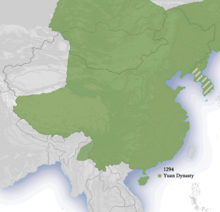
The Yuan dynasty in Inner Asia was the domination of the Yuan dynasty in Inner Asia in the 13th and the 14th centuries. The Borjigin rulers of the Yuan came from the Mongolian steppe, and the Mongols under Kublai Khan established the Yuan dynasty (1271–1368) based in Khanbaliq (modern Beijing). The Yuan was a Chinese dynasty that incorporated many aspects of Mongol and Inner Asian political and military institutions.[1]
The Yuan directly ruled over parts of modern China, Korea, Mongolia, and Siberia (Russia). Specifically, the Yuan extended to Manchuria (modern Northeast China and Outer Manchuria), Mongolia, southern Siberia, the Tibetan Plateau and parts of Xinjiang. People from these 'Inner Asian' regions either belonged to the 'Mongol' class, 'Northern Han' class, or 'Semu' class.
In addition, the Yuan emperors held nominal suzerainty over the three western Mongol khanates (the Golden Horde, the Chagatai Khanate and the Ilkhanate).
- ^ Murowchick, Robert E. (1994). China: Ancient Culture, Modern Land. Norman: University of Oklahoma Press. p. 145. ISBN 0-8061-2683-3.
© MMXXIII Rich X Search. We shall prevail. All rights reserved. Rich X Search
